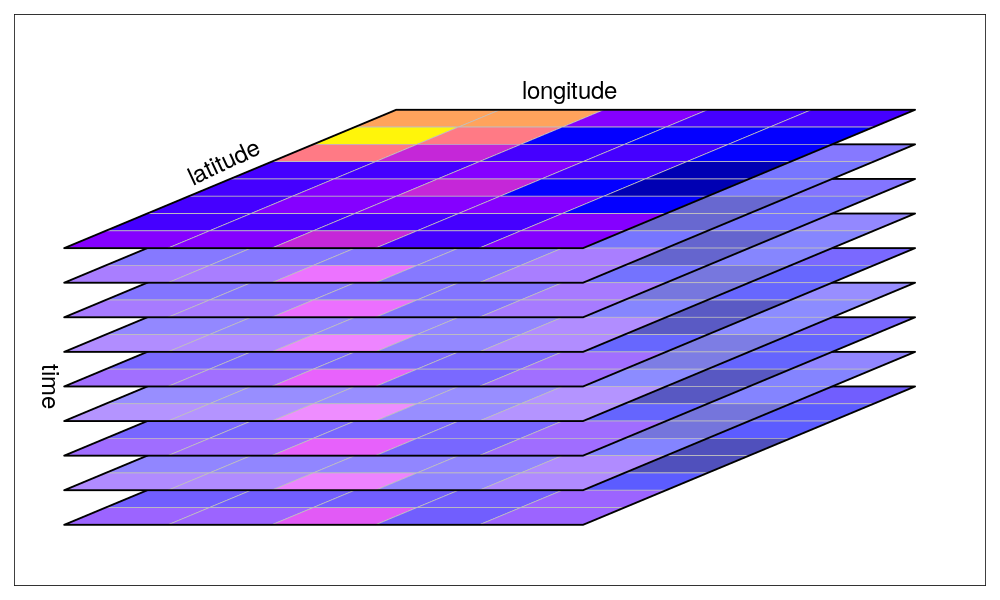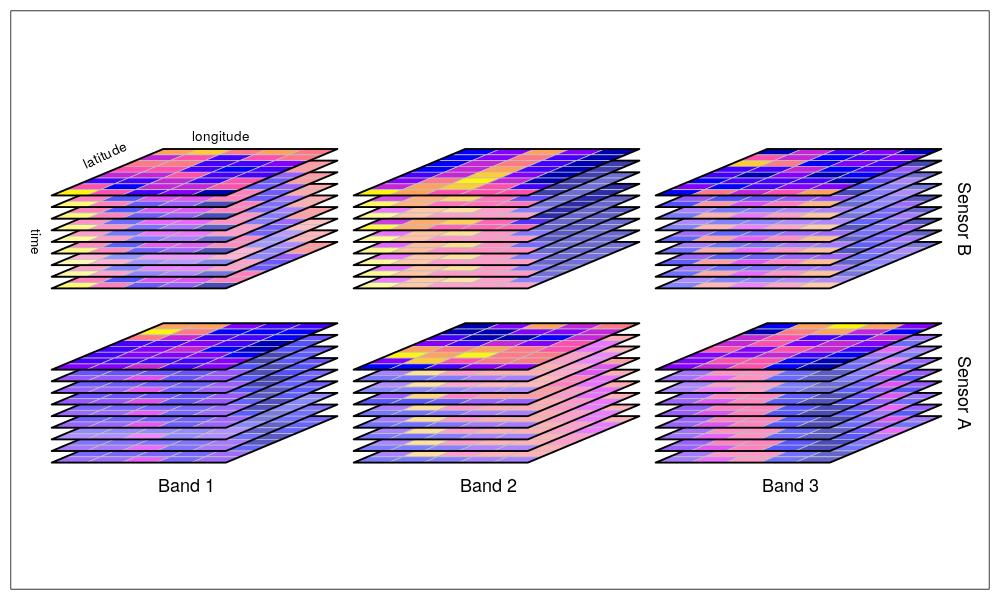stars
 stars copied to clipboard
stars copied to clipboard
Spatiotemporal Arrays, Raster and Vector Data Cubes
Spatiotemporal Arrays: Raster and Vector Datacubes
Spatiotemporal data often comes in the form of dense arrays, with space and time being array dimensions. Examples include
- socio-economic or demographic data,
- environmental variables monitored at fixed stations,
- raster maps
- time series of satellite images with multiple spectral bands,
- spatial simulations, and
- climate or weather model output.
This R package provides classes and methods for reading, manipulating, plotting and writing such data cubes, to the extent that there are proper formats for doing so.
Raster and vector data cubes
The canonical data cube most of us have in mind is that where two dimensions represent spatial raster dimensions, and the third time (or band), as e.g. shown here:

By data cubes however we also consider higher-dimensional cubes (hypercubes) such as a five-dimensional cube where in addition to time, spectral band and sensor form dimensions:

or lower-dimensional cubes such as a raster image:
suppressPackageStartupMessages(library(dplyr))
library(stars)
# Loading required package: abind
# Loading required package: sf
# Linking to GEOS 3.10.1, GDAL 3.4.0, PROJ 8.2.0; sf_use_s2() is TRUE
tif = system.file("tif/L7_ETMs.tif", package = "stars")
read_stars(tif) %>%
slice(index = 1, along = "band") %>%
plot()

Raster data do not need to be regular and aligned with North/East, and
package stars supports besides regular also rotated, sheared,
rectilinear and curvilinear rasters:

Vector data cubes arise when we do not have two regularly discretized spatial dimensions, but a single dimension that points to distinct spatial feature geometries, such as polygons (e.g. denoting administrative regions):

or points (e.g. denoting sensor locations):

NetCDF’s CF-convention calls this a discrete axis.
NetCDF, GDAL
stars provides two functions to read data: read_ncdf and
read_stars, where the latter reads through GDAL. (In the future, both
will be integrated in read_stars.) For reading NetCDF files, package
RNetCDF is used, for reading through GDAL, package sf provides the
binary linking to GDAL.
For vector and raster operations, stars uses as much as possible the
routines available in GDAL and PROJ (e.g. st_transform, rasterize,
polygonize, warp). Read more about this in the vignette on
vector-raster conversions, reprojection,
warping.
Out-of-memory (on-disk) rasters
Package stars provides stars_proxy objects (currently only when read
through GDAL), which contain only the dimensions metadata and pointers
to the files on disk. These objects work lazily: reading and processing
data is postponed to the moment that pixels are really needed (at plot
time, or when writing to disk), and is done at the lowest spatial
resolution possible that still fulfills the resolution of the graphics
device. More details are found in the stars proxy
vignette.
The following methods are currently available for stars_proxy objects:
methods(class = "stars_proxy")
# [1] [ [[<- [<- adrop
# [5] aggregate aperm as.data.frame c
# [9] coerce dim droplevels filter
# [13] hist initialize is.na Math
# [17] merge mutate Ops plot
# [21] predict print pull rename
# [25] select show slice slotsFromS3
# [29] split st_apply st_as_sf st_as_stars
# [33] st_crop st_dimensions<- st_downsample st_mosaic
# [37] st_redimension st_sample st_set_bbox transmute
# [41] write_stars
# see '?methods' for accessing help and source code
Raster and vector time series analysis example
In the following, a curvilinear grid with hourly precipitation values of a hurricane is imported and the first 12 time steps are plotted:
prec_file = system.file("nc/test_stageiv_xyt.nc", package = "stars")
(prec = read_stars(gdal_subdatasets(prec_file)[[1]]))
# stars object with 3 dimensions and 1 attribute
# attribute(s):
# Min. 1st Qu. Median Mean 3rd Qu.
# Total_precipitation_surface_1_... [kg/m^2] 0 0 0.75 4.143009 4.63
# Max.
# Total_precipitation_surface_1_... [kg/m^2] 163.75
# dimension(s):
# from to offset delta refsys point
# x 1 87 NA NA WGS 84 NA
# y 1 118 NA NA WGS 84 NA
# time 1 23 2018-09-13 19:00:00 UTC 1 hours POSIXct NA
# values x/y
# x [87x118] -80.6113 [°],...,-74.8822 [°] [x]
# y [87x118] 32.4413 [°],...,37.6193 [°] [y]
# time NULL
# curvilinear grid
# or: (prec = read_ncdf(prec_file, curvilinear = c("lon", "lat"), ignore_bounds = TRUE))
sf::read_sf(system.file("gpkg/nc.gpkg", package = "sf"), "nc.gpkg") %>%
st_transform(st_crs(prec)) -> nc # transform from NAD27 to WGS84
nc_outline = st_union(st_geometry(nc))
plot_hook = function() plot(nc_outline, border = 'red', add = TRUE)
prec %>%
slice(index = 1:12, along = "time") %>%
plot(downsample = c(3, 3, 1), hook = plot_hook)

and next, intersected with with the counties of North Carolina, where the maximum precipitation intensity was obtained per county, and plotted:
a = aggregate(prec, by = nc, FUN = max)
plot(a, max.plot = 23, border = 'grey', lwd = .5)

We can integrate over (reduce) time, for instance to find out when the maximum precipitation occurred. The following code finds the time index, and then the corresponding time value:
index_max = function(x) ifelse(all(is.na(x)), NA, which.max(x))
st_apply(a, "geometry", index_max) %>%
mutate(when = st_get_dimension_values(a, "time")[.$index_max]) %>%
select(when) %>%
plot(key.pos = 1, main = "time of maximum precipitation")

Other packages for data cubes
gdalcubes
Package gdalcubes can be used to create data cubes (or functions from
them) from image collections, sets of multi-band images with varying
- spatial resolution
- spatial extent
- coordinate reference systems (e.g., spread over multiple UTM zones)
- observation times
and does this by resampling and/or aggregating over space and/or time. It reuses GDAL VRT’s and gdalwarp for spatial resampling and/or warping, and handles temporal resampling or aggregation itself.
ncdfgeom
ncdfgeom reads and writes vector data cubes from and to netcdf files
in a standards-compliant way.
raster
Package raster is a powerful package for handling raster maps and
stacks of raster maps both in memory and on disk, but does not address
- non-raster time series,
- multi-attribute rasters time series
- rasters with mixed type attributes (e.g., numeric, logical, factor, POSIXct)
- rectilinear or curvilinear rasters
A list of stars commands matching existing raster commands is found
in this
wiki.
A list of translations in the opposite direction (from stars to
raster) still needs to be made.
Other stars resources:
- blog posts: first, second, third
- vignettes: first, second, third, fourth, fifth
- the original R Consortium proposal.
Acknowledgment
This project has been realized with financial support from the
